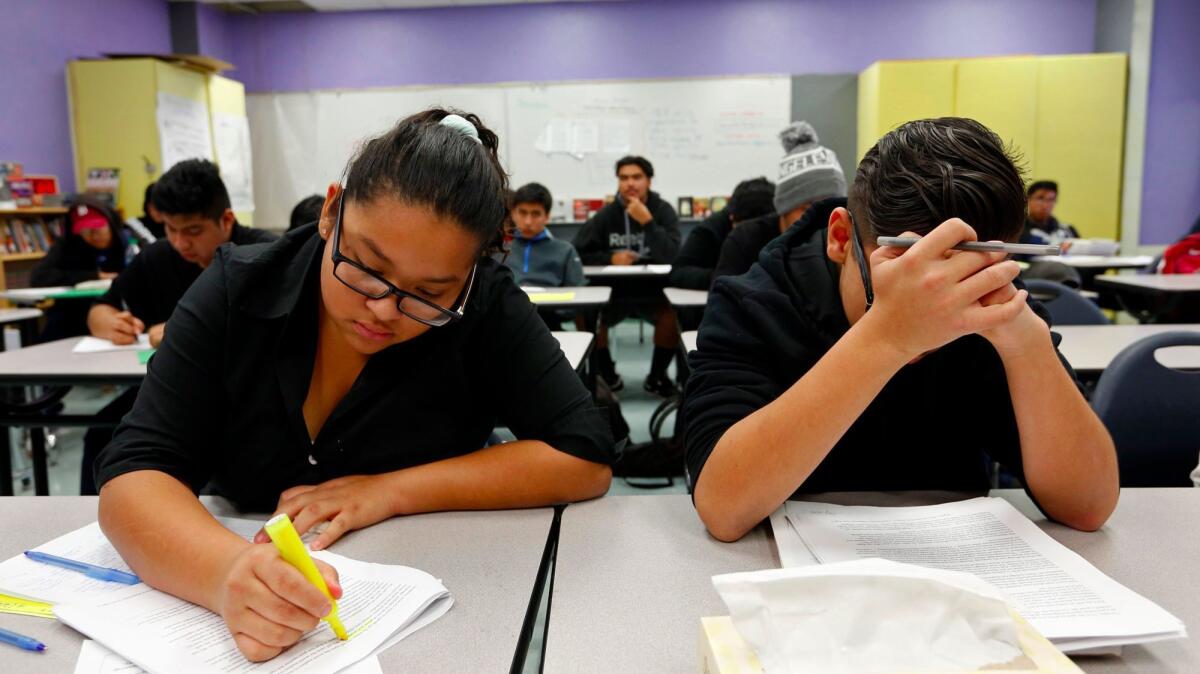Editorial: The pendulum swings too far on school accountability

Is California’s commitment to school accountability dead? Probably not, but it’s certainly withering.
The days of California’s Academic Performance Index and the federal No Child Left Behind Act are over, and they won’t be missed. The API’s obsessive insistence on measuring schools solely on the basis of a couple of annual tests led to an era in which arts, science and physical fitness were given short shrift. No Child Left Behind layered a set of rigid, punitive rules on top, and the Obama administration’s attempts to dictate school policy through its Race to the Top initiative was overly intrusive.
The new federal education law, the Every Student Succeeds Act, will at least be less harsh, and under the state’s new accountability system, there’s a lot more to rating a school than its scores on the annual statewide tests. So far, so good.
But there are distressing signs that instead of returning to a common-sense middle ground on accountability, the education pendulum is swinging as far as possible in the other direction.
Accountability “dashboard”: We’ve been complaining for months about the state’s nearly indecipherable new accountability system, which gives parents little idea of how well a school is doing overall. The state has gone from having one simplistic API score for schools, based almost solely on their English and math test results, to a multicolor grid showing measurements on a plethora of factors, including some that don’t seem to have much to do with how much kids are learning. There’s no summative score for parents to weigh one school against another.
In fact, parents went without measurements of any kind for years; California sensibly dropped the API to avoid confusion and backlash as it began the transition to the Common Core curriculum standards and related tests. But the state waited five years for something new, and it’s disappointing that all the collective patience has been rewarded with a color-the-blanks chart that provides so little public transparency.
Every Student Succeeds Act: By Sept. 18, all states must submit their new accountability plans to the U.S. Department of Education under ESSA, and the law gives them a lot of leeway about how they proceed. Still, they’re supposed to identify the bottom-performing 5% of schools and devise a blueprint for how they’ll intervene to help those students get a better education. They’re also supposed to have a plan for bringing more qualified teachers to schools with high concentrations of inexperienced educators who aren’t credentialed in the subject they’re teaching. That happens mostly at high-poverty schools.
California’s blueprint has none of that right now, aside from a vague plan to label schools with dismal ratings in every category on their “dashboard” as in need of intervention. That’s only 90 schools; the bottom 5% adds up to about 300 schools. How the state will identify the rest is unclear; nor is it clear whether fair or better performance on less germane factors like suspensions or parent engagement spare a school from state intervention even if its test scores and graduation rates are persistently miserable.
Remarkably, the state isn’t planning to give the federal government any information on how it will intervene at the worst-performing schools or bring more highly qualified teachers to the schools that need them — because it doesn’t want to make a commitment that could last longer than the Trump administration. But the law is here until it’s changed by Congress, regardless of who’s in the White House; students shouldn’t have to wait years for the state to commit to improving their education.
The state might bring out a new version of its ESSA plan before it’s sent to Washington. But time is running out and the State Board of Education has been stubborn about clinging to its vague and problematic system. If it doesn’t make serious changes, the U.S. Education Department should reject the plan and require California to do some remedial work.
Local Control Funding Formula: California Gov. Jerry Brown came up with the new formula for financing K-12 education after the state passed Proposition 30 in 2012, bringing new sales tax revenue to schools that had been starved during the recession. The governor cleverly used the opportunity to hit the reset button, replacing the state’s crazily complicated and outdated formulas for per-pupil funding with an admirably straightforward and progressive system that delivers substantial extra sums to districts to help educate low-income and foster kids, and those who still were learning English.
Five years later, though, it’s unclear how much of that money has actually been spent on the students for whom it was intended. From the start, this page questioned how the state would ensure that the money was properly spent, and the answer was always that school districts would be required to create local plans for improvement. They have done that, but most of the plans have skirted the issue of fiscal responsibility with the new funds. The inability or unwillingness of districts to answer what should be a simple question about how they’re using the additional money should be raising red flags for state officials.
The state Assembly, at least, saw those flags and passed a bill (AB 1321) that would have required per-pupil spending reports for each school, a reasonable if imperfect proxy for seeing how the money is being spent. But the measure, which was supported by an array of civic and community groups, foundered in the Senate Appropriations Committee in the face of opposition from school administrators and the teachers’ union.
It was a long, rough ride during the years of No Child Left Behind and API scores. But in its effort to recover from that harsh period, California appears to be losing its sense of urgency for closing the achievement gap for its most vulnerable students. The last thing state schools need is a return to the days when low-income and minority students in California were left to whatever policies their local districts found appealing — or convenient.
Follow the Opinion section on Twitter @latimesopinionand Facebook
More to Read
A cure for the common opinion
Get thought-provoking perspectives with our weekly newsletter.
You may occasionally receive promotional content from the Los Angeles Times.






